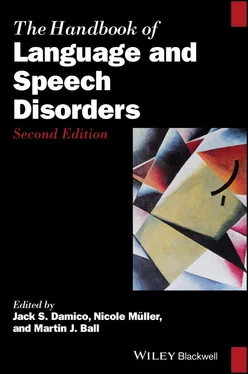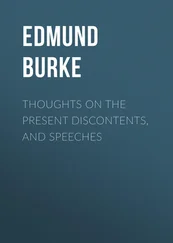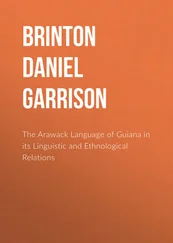46 Levy, Y., & Eilam, A. (2013). Pathways to language: A naturalistic study of children with Williams syndrome and children with Down syndrome. Journal of Child Language, 40, 106–138.
47 Lowery, M. C., Morris, C. A., Ewart, A., Brothman, L. J., Zhu, X. L., Leonard, C. O., … Brothman, A. R. (1995). Strong correlation of elastin deletions, detected by FISH, with Williams syndrome. American Journal of Human Genetics, 57, 49–53.
48 Marcus, G., & Rabagliati, H. (2006). What developmental disorders can tell us about the nature and origins of language? Nature Neuroscience, 9(10), 1226–1229.
49 Marini, A., Martelli, S., Gagliardi, C., Fabbro, F., & Borgatti, R. (2010). Narrative language in Williams syndrome and its neuropsychological correlates. Journal of Neurolinguistics, 23(2), 97–111.
50 Mason‐Apps, E., Stojanovik, V., Houston‐Price, C., Seager, E., & Buckley, S. (2020). Do infants with Down syndrome show an early receptive language advantage? Journal of Speech, Language, and Hearing Research, 63(2), 585–598.
51 Mattys, S. L., White, L., & Melhorn, J. F. (2005). Integration of multiple speech segmentation cues: A hierarchical framework. Journal of Experimental Psychology: General, 134(4), 477.
52 Mervis, C., & Bertrand, J. (1997). Developmental relations between cognition and language: Evidence from Williams syndrome. In L. B. Adamson & M. A. Romsky (Eds.), Communication and language acquisition: Discoveries from atypical development (pp. 75–160). Baltimore, MD: Paul Brookes.
53 Mervis, C. B., & Klein‐Tasman, B. P. (2000). Williams syndrome: Cognition, personality, and adaptive behaviour. Mental Retardation and Developmental Disabilities Research Reviews, 6, 148–158.
54 Mervis, C. B., Klein‐Tasman, B. P., & Mastin, M. E. (2001). Adaptive behaviour of 4‐ through 8‐year old children with Williams syndrome. American Journal of Mental Retardation, 106, 82–93.
55 Mervis, C. B., Morris, C. A., Bertrand, J., & Robinson, B. F. (1999). William syndrome: Findings from an integrated programme of research. In H. Tager‐Flusberg (Ed.), Neurodevelopmental disorders: Contributions to a new framework from cognitive neuroscience (pp. 65–110). Cambridge MA: MIT Press.
56 Mervis, C. B., Robinson, B. F., Rowe, M. L., Becerra, A. M., & Klein‐Tasman, B. P. (2003). Language abilities of individuals with Williams syndrome. International Review of Research in Mental Retardation, 27, 35–81.
57 Miller, J. (1996). The search for the phenotype of disordered language performance. In M. L. Rice (Ed.), Towards a genetics of language (pp. 297–314). Mahwah, NJ: Erlbaum.
58 Miller, J. (1999). Profiles of language development in children with Down syndrome. In J. F. Miller, M. Leddy, & L. A. Leavitt (Eds.), Improving the communication of people with Down syndrome (pp. 11–39). Baltimore, MD: Paul H. Brookes.
59 Musolino, J., Chunyo, G., & Landau, B. (2010). Uncovering knowledge of core syntactic and semantic principles in individuals with Williams syndrome. Language Learning and Development, 6(2), 126–161.
60 Næss, K. A. B., Lyster, S. A. H., Hulme, C., & Melby‐Lervåg, M. (2011). Language and verbal short‐term memory skills in children with Down syndrome: A meta‐analytic review. Research in Developmental Disabilities, 32(6), 2225–2234.
61 Oliver, B., & Buckley, S. (1994). The language development of children with Down syndrome: First words to two‐word phrases. Down’s Syndrome, Research and Practice, 2(2), 71–75.
62 Parker, S. E., Mai, C. T., Canfield, M. A., Rickard, R., Wang, Y., Meyer, R. E., … Correa, A. (2010). Updated national birth prevalence estimates for selected birth defects in the United States, 2004–2006. Birth Defects Research Part A: Clinical and Molecular Teratology, 88(12), 1008–1016.
63 Paterson, S. J., Girelli, J. H., Gsodl, M. K., Johnson, M. H., & Karmiloff‐Smith, A. (1999). Cognitive modularity and genetic disorders. Science, 286, 2355–2358.
64 Penke, M., & Krause, M. (2004). Regular and irregular inflectional morphology in German Williams syndrome. In S. Bartke & J. Siegmüller (Eds.), Williams syndrome across languages (pp. 245–270). Amsterdam, the Netherlands: John Benjamins.
65 Perovic, A. (2002). Language in Down syndrome: Delay of principle A effect? Durham Working Papers in Linguistics, 8, 97–110.
66 Perovic, A., & Wexler, K. (2010). Development of verbal passive in Williams syndrome. Journal of Speech, Language, and Hearing Research, 53(5), 1294–1306.
67 Pinker, S. (1999). Words and rules. The ingredients of language. London, UK: Weidenfeld and Nicolson.
68 Pléh, C., Lukács, A., & Racsmány, M. (2003). Morphological patterns in Hungarian children with Williams syndrome and the rule debates. Brain and Language, 86, 377–383.
69 Reilly, J., Klima, E. S., & Bellugi, U. (1990). Once more with feeling: Affect and language in atypical populations. Development and Psychopathology, 2, 367–391.
70 Rice, M., Warren, S., & Betz, S. K. (2005). Language symptoms of developmental language disorders: An overview of autism, Down syndrome, fragile X, specific language impairment, and Williams syndrome. Applied PsychoLinguistics, 26, 7–27.
71 Ring, M., & Clahsen, H. (2005). Distinct patterns of language impairment in Down’s syndrome and Williams syndrome: The case of syntactic chains. Journal of Neurolinguistics, 18, 479–501.
72 Rondal, J. (2001). Language in mental retardation: Individual and syndromic differences and neurogenetic variation. Swiss Journal of Psychology, 60, 161–178.
73 Rondal, J., & Edwards, S. (1997). Language in mental retardation. London, UK: Whurr Publishers.
74 Rossi, N. F., Sampaio, A., Gonçalves, Ó. F., & Giacheti, C. M. (2011). Analysis of speech fluency in Williams syndrome. Research in Developmental Disabilities, 32(6), 2957–2962.
75 Semel, E., & Rosner, S. (2003). Understanding Williams syndrome: Behavioural patterns and interventions. Mahwah, NJ: Lawrence Erlbaum Associates.
76 Sparrow, S. S., Balla, D., & Cichetti, D. (1984). Vineland adaptive behaviour scales. Circle Pines, MN: American Guidance Service.
77 Stojanovik, V. (2006). Social interaction deficits in Williams syndrome. Journal of Neurolinguistics, 19, 157–173.
78 Stojanovik, V., & James, D. (2006). A short‐term longitudinal study of a child with Williams syndrome. International Journal of Language & Communication Disorders, 41(2), 213–223.
79 Stojanovik, V., Perkins, M., & Howard, S. (2001). Language and conversational abilities in Williams syndrome: How good is good? International Journal of Language and Communication Disorders, 36(Suppl), 234–240.
80 Stojanovik, V., Perkins, M., & Howard, S. (2004). Williams syndrome and specific language impairment do not support claims for developmental double associations and innate modularity. Journal of Neurolinguistics, 17, 403–424.
81 Stojanovik, V., Zimmerer, V., Setter, J., Hudson, K., Poyraz‐Bilgin, I., & Saddy, D. (2018). Artificial grammar learning in Williams syndrome and in typical development: The role of rules, familiarity, and prosodic cues. Applied PsychoLinguistics, 39(2), 327–353.
82 Stromme, P., Bjornstad, P. G., & Ramstad, K. (2002). Prevalence estimation of Williams syndrome. Journal of Child Neurology, 17, 269–271.
83 Te Kaat‐van den Os, D. T., Volman, C., Jongmans, M., & Lauteslager, P. (2017). Expressive vocabulary development in children with Down syndrome: A longitudinal study. Journal of Policy and Practice in Intellectual Disabilities, 14(4), 311–318.
84 Thomas, M. S. C., Grant, J., Barham, Z., Gsödl, M., Laing, E., Lakusta, L., … Karmiloff‐Smith, A. (2001). Past tense formation in Williams syndrome. Language & Cognitive Processes, 16, 143–176.
85 Udwin, O., & Yule, W. (1991). A cognitive and behavioural phenotype in Williams syndrome. Journal of Clinical and Experimental Neuropsychology, 32, 129–141.
Читать дальше












